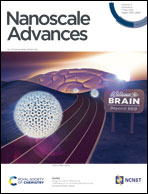Unveiling the multiscale morphology of chemically stabilized proton exchange membranes for fuel cells by means of Fourier and real space studies†
Abstract
We recently presented the elaboration and functional properties of a new generation of hybrid membranes for PEMFC applications showing promising performances and durability. The strategy was to form, inside a commercial sPEEK membrane, via in situ sol–gel (SG) synthesis, a reactive SG phase able to reduce oxidative species generated during FC operation. In order to understand structure-properties interplay, we use a combination of direct space (AFM/3D FIB-SEM) and reciprocal space (SANS/WAXS) techniques to cover dimensional scales ranging from a hundred to few nanometers. AFM modulus images showed the SG phase distributed into spherical domains whose size increases with the SG uptake (ca. 100–200 nm range). Using contrast variation SANS, we observed that the sPEEK nanostructure is mostly unaffected by the insertion of the SG phase which presents a fractal-like multiscale structure. Additionally, the size of both the particles (aggregates/primary) is much too large to be sequestered in the ionic pathways of sPEEK. These findings indicate that the SG-NPs mainly grow within the amorphous interbundle domains. Noticeable rightward shift and widening of the ionomer peak are observed with the SG content, suggesting ion channel compression and greater heterogeneity of the ionic domain size. The SG phase develops in the interbundle regions with a limited impact on the water uptake but leading to a discontinuity of ionic conductivity. This Fourier and real spaces study clarifies the structure of the hybrid membranes and brings into the question the ideal distribution/localization of the SG phase to optimize the membrane's stabilization.



 Please wait while we load your content...
Please wait while we load your content...